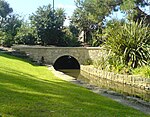Bournemouth Gardens, England
1830s establishments in EnglandEnglish gardens in English Landscape Garden styleGardens in DorsetGrade II listed garden and park buildingsGrade II listed parks and gardens in Dorset ... and 1 more
Tourist attractions in Bournemouth

Bournemouth Gardens are Grade II listed gardens in the town of Bournemouth, Dorset, England. Created in the nineteenth century, the gardens follow the towns eponymous River Bourne three kilometres from the historic boundary with Poole south-eastwards into Bournemouth Town Centre. The Gardens are home to a number of significant Bournemouth landmarks and listed buildings such as; the Town Hall, the War Memorial, St. Andrew's Church and the Pavilion Theatre. Bournemouth Gardens have been Green Flag Award winners since 1999.
Excerpt from the Wikipedia article Bournemouth Gardens, England (License: CC BY-SA 3.0, Authors, Images).Bournemouth Gardens, England
Pier Approach,
Geographical coordinates (GPS) Address Nearby Places Show on map
Geographical coordinates (GPS)
| Latitude | Longitude |
|---|---|
| N 50.717369444444 ° | E -1.8758333333333 ° |
Address
Pier Approach
BH2 5AA , West Cliff
England, United Kingdom
Open on Google Maps










